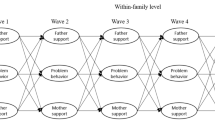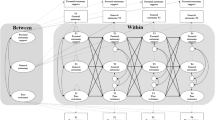Abstract
Coping research has neglected the study of the reciprocal links between parents’ and adolescents’ coping behaviors and the potential influence of parental support for the development of adolescent autonomy. This study, therefore, analyzed the coping behaviors of fathers, mothers, and children (53% females) in 196 families who participated in a four-year longitudinal study that started when the child was an early adolescent. The results of cross-lagged panel design models examining direct links between parents’ and their children’s coping styles suggested that parents and children do not affect each others’ abilities to cope with family stress over time. However, indirect relationships between parents’ and children’s coping styles via autonomy support in the family were found. Both the parents’ and adolescents’ perceptions of autonomy support in the family were important in shaping their respective coping styles. The child’s individual characteristics (e.g., gender and physical maturity) had a greater influence on the fine-tuning of mothers’ coping behaviors than on the fathers’. The findings underscore the significance of autonomy-enhancing parent–child interactions for the development of adolescent coping.



Similar content being viewed by others
References
Bentler, P. M. (1990). Comparative fit indexes in structural models. Psychological Bulletin, 107, 238–246.
Bentler, P. M., & Bonett, D. G. (1980). Significance tests and goodness-of-fit in the analysis of covariance structures. Psychological Bulletin, 88, 588–606.
Beyers, W., Goosens, L., Vansant, I., & Moors, E. (2003). A structural model of autonomy in middle and late adolescence: Connectedness, separation, detachment, and agency. Journal of Youth and Adolescence, 32, 351–365.
Boykin McElhaney, K., & Allen, J. P. (2001). Autonomy and adolescent social functioning: The moderating effect of risk. Child Development, 72, 220–235.
Browne, M. W., & Cudeck, R. (1993). Alternative ways of assessing model fit. In K. A. Bollen & J. S. Long (Eds.), Testing structural equation models (pp. 136–162). London: Sage.
Bulcroft, R. A., Carmody, D. C., & Bulcroft, K. A. (1996). Pattern of parental independence giving to adolescents: Variations by race, age, and gender of the child. Journal of Marriage and the Family, 58, 866–883.
Bumpus, M. F., Crouter, A. C., & McHale, S. M. (2001). Parental autonomy granting in adolescence: Exploring gender differences in context. Developmental Psychology, 37, 163–173.
Butler, R., & Shalit-Naggar, R. (2008). Gender and patterns of concerned responsiveness in representations of the mother-daughter and mother-son relationship. Child Development, 79, 836–851.
Butler, J. M., Skinner, M., Gelfand, D., Berg, C. A., & Wiebe, D. (2007). Maternal parenting style and adjustment in adolescents with Type 1 diabetes. Journal of Pediatric Psychology, 23, 1–11.
Collins, A. W., Laursen, B., Mortensen, N., Luebker, C., & Ferreira, M. (1997). Conflict processes and transitions in parent and peer relationships: Implications for autonomy and regulation. Journal of Adolescent Research, 12, 178–198.
Compas, B. E., Connor-Smith, J. K., Saltzman, H., Thomsen, A. H., & Wadsworth, M. E. (2001). Coping with stress during childhood and adolescence: Problems, progress, and potential in theory and research. Psychological Bulletin, 127, 87–127.
Curran, P. J. (2000). A latent curve framework for the study of developmental trajectories in adolescent substance use. In J. S. Rose, L. Chassin, C. C. Presson, & S. J. Sherman (Eds.), Multivariate application in substance use research: New methods for new questions (pp. 1–4). Mahwah, NJ: Erlbaum.
Deci, E. L., La Guardia, J. G., Moller, A. C., Scheiner, M. J., & Ryan, R. M. (2006). On the benefits of living as well as receiving autonomy support: Mutuality in close friendships. Personality and Social Psychology Bulletin, 32, 313–327.
Dowdy, B. B., & Kliewer, W. (1998). Dating, parent-adolescent conflict, and behavioral autonomy. Journal of Youth and Adolescence, 27, 473–492.
Eisenberg, N., Fabes, R. A., & Guthrie, I. K. (1997). Coping with stress: The roles of regulation and development. In S. A. Wolchik & I. N. Sandler (Eds.), Handbook of children’s coping: Linking theory and intervention. Issues in clinical child psychology (pp. 41–70). New York: Plenum Press.
Feldman, S., & Rosenthal, D. A. (1990). The acculturation of autonomy expectations in Chinese high schoolers residing in two Western nations. International Journal of Psychology, 25, 259–281.
Fox, N. A., Henderson, H. A., Marshall, P. J., Nichols, K. E., & Ghera, M. A. (2005). Behavioral inhibition: Linking biology and behavior within a developmental framework. Annual Review of Psychology, 56, 235–262.
Fuligni, A. J. (1998). Authority, autonomy, and parent-adolescent conflict and cohesion: A study of adolescents from Mexican, Chinese, Filipino, and European backgrounds. Developmental Psychology, 34, 782–792.
Gilligan, C. (1996). The centrality of relationship in human development: A puzzle, some evidence, and a theory. In G. G. Noam & K. W. Fischer (Eds.), Development and vulnerability in close relationships (pp. 237–261). Mahwah, NJ: Lawrence Erlbaum.
Grotevant, H. D., & Cooper, C. R. (1986). Individuation in family relationships. A perspective on individual differences in the development of identity and role-taking skill in adolescence. Human Development, 9, 82–100.
Gutman, L. M., & Eccles, J. S. (2007). Stage-environment fit during adolescence: Trajectories of family relations and adolescent outcomes. Developmental Psychology, 43, 522–537.
Hawkins, D. N., Amato, P. R., & King, V. (2006). Parent-adolescent involvement: The relative influence of parent gender and residence. Journal of Marriage and the Family, 68, 125–136.
Hoff, E., Laursen, B., & Tardiff, T. (2002). Socioeconomic status and parenting. In M.-H. Bornstein (Ed.), Handbook of parenting (pp. 231–252). Mahwah, NJ: Erlbaum.
Holmbeck, G. N., Paikoff, R. L., & Brooks-Gunn, J. (1995). Parenting adolescents. In M. H. Bornstein (Ed.), Handbook of parenting: Vol. 1. Children and parenting (pp. 91–118). Mahwah, NJ: Lawrence Erlbaum Associates.
Hu, L., & Bentler, P. M. (1998). Fit indices in covariance structure modeling: Sensitivity to underparameterized model misspecification. Psychological Bulletin, 3, 424–453.
Karavasilis, L., Doyle, A. B., & Markiewicz, D. (2003). Associations between parenting style and attachment to mother in middle childhood and adolescence. International Journal of Behavioral Development, 27, 153–164.
Kerr, M., & Stattin, H. (2003). Parenting of adolescents: Action or reaction? In A. C. Crouter & A. Booth (Eds.), Children’s influence on family dynamics: The neglected side of family relationships (pp. 121–152). Mahwah, NJ: Erlbaum.
Kerr, M., Stattin, H., & Pakalniskiene, V. (2008). Parents react to adolescent problem behavior by worrying more and monitoring less. In M. Kerr, H. Stattin, & R. C. M. E. Engels (Eds.), What can parents do? New insight into the role of parents in adolescent problem behavior (pp. 91–112). New York: Wiley.
Kliewer, W., Fearnow, M. D., & Miller, P. A. (1996). Coping socialization in childhood. Tests of paternal and maternal influences. Child Development, 67, 2339–2357.
Kliewer, W., Sandler, I., & Wolchik, S. (1994). Family socialization of threat appraisal and coping: Coaching, modeling, and family context. In K. Hurrelman & F. Nestmann (Eds.), Social networks and social support in childhood and adolescence (pp. 271–291). Berlin: de Gruyter.
Klink, J. L., Byars-Winston, A., & Bakken, L. L. (2008). Coping efficacy and perceived family support: Potential factors for reducing stress in premedical students. Medical Education, 42, 572–579.
Laird, R. D., Pettit, G. S., Bates, J. E., & Dodge, K. A. (2003). Parents’ monitoring relevant knowledge and adolescent delinquent behaviour: Evidence of correlated developmental changes in reciprocal influences. Child Development, 74, 752–768.
Larson, R. W., Richards, M. H., Moneta, G. B., Holmbeck, G., & Duckett, E. (1996). Changes in adolescents daily interactions with their families from age 10 to 18: Disengagement versus transformation. Developmental Psychology, 32, 744–754.
Laursen, B., Wilder, D., Noack, P., & Williams, V. (2000). Adolescent perceptions of reciprocity, authority and closeness in relationships with mothers, fathers and friends. International Journal of Behavioral Development, 24, 464–471.
Lazarus, R. S. (1993). Coping theory and research: Past, present, and future. Psychometric Medicine, 55, 234–247.
Lazarus, R. S. (1998). Fifty years of the research and theory of R. S. Lazarus. Mahwah, NJ: Erlbaum.
Lytton, H. (1990). Child and parent effects in boys’ conduct disorder: A reinterpretation. Developmental Psychology, 26, 683–697.
McCarthy, C. J., Lambert, R. G., & Seraphine, A. E. (2004). Adaptive family functioning and emotion regulation capacities as predictors of college students’ appraisals and emotion valence following conflict with their parents. Cognition and Emotion, 18, 97–124.
McCubbin, H. I., Thompson, A. I., & McCubbin, M. A. (1996). Family assessment: Resiliency coping and adaptation: Inventories for research and practice. Madison, WI: University of Wisconsin.
McPherson, M., Smith-Lovin, L., & Brashears, M. E. (2006). Social isolation in America: Changes in core discussion networks over two decades. American Sociological Review, 71, 353–375.
Moos, R. H. (1974). Family Environment Scale (FES) Preliminary manual. Palo Alto, CA: Social Ecology Laboratory, Department of Psychiatry, Stanford University.
Muthén, L. K., & Muthén, B. O. (2006). Mplus users guide. Los Angeles, CA: Authors.
Nomaguchi, K. M. (2008). Gender, family structure, and adolescents’ primary confidants. Journal of Marriage and the Family, 70, 1213–1227.
Power, T. G. (2004). Stress and coping in childhood: The parent’s role. Parenting Science and Practice, 4, 271–317.
Raley, S., & Bianchi, S. (2006). Sons, daughters, and family processes: Does gender of child matter? Annual Review of Sociology, 32, 401–421.
Romich, J. L., Lundberg, S., & Tsang, K. P. (2009). Independence giving or autonomy taking? Childhood predictors of decision sharing patterns between young adolescents and parents. Journal of Research on Adolescence, 19, 587–600.
Seiffge-Krenke, I. (1995). Stress, coping, and relationships in adolescence. Mahwah, NJ: Erlbaum.
Seiffge-Krenke, I. (1999). Families with daughters, families with sons: Different challenges for family relationships and marital satisfaction? Journal of Youth and Adolescence, 3, 325–342.
Seiffge-Krenke, I. (2006). Coping with relationship stressors: The impact of different working models of attachment and links to adaptation. Journal of Youth and Adolescence, 35, 25–39.
Seiffge-Krenke, I., Aunola, K., & Nurmi, J.-E. (2009). Changes in stress perception and coping during adolescence: The role of situational and personal factors. Child Development, 80, 259–279.
Seiffge-Krenke, I., & Beyers, W. (2005). Coping trajectories from adolescence to young adulthood: Links to attachment state of mind. Journal of Research on Adolescence, 15, 561–582.
Shulman, S., & Seiffge-Krenke, I. (1997). Fathers and adolescents. Developmental and clinical perspectives. London, New York: Routledge.
Siegal, M. (1987). Are sons and daughters treated more differently by fathers than by mothers? Developmental Review, 7, 183–209.
Silverberg, S. B., & Steinberg, L. (1990). Psychological well-being of parents with early adolescent children. Developmental Psychology, 26, 658–666.
Skinner, E. A., & Zimmer-Gembeck, M. J. (2007). The development of coping. Annual Review of Psychology, 58, 119–144.
Smetana, J. G., Metzger, A., Gettman, D. C., & Campione-Barr, N. (2006). Disclosure and secrecy in adolescent-parent relationships. Child Development, 77, 201–217.
Steinberg, L. (2001). We know some things: Parent-adolescent relationships in retrospect and prospect. Journal of Research on Adolescence, 11, 1–19.
Tamres, L. K., Janicki, D., & Helgeson, V. S. (2002). Sex differences in coping behavior: A meta-analytic review and an examination of relative coping. Personality and Social Psychology Review, 6, 2–30.
Tucker, L. R., & Lewis, C. (1973). The reliability coefficients for maximum likelihood factor analysis. Psychometrica, 3, 1–10.
Wray-Lake, L., Crouter, A. C., & McHale, S. M. (2010). Developmental pattern in decision making autonomy across middle childhood and adolescence: European-American parents’ perspectives. Child Development, 81, 636–651.
Zimmer-Gembeck, M. J., & Locke, E. M. (2007). The socialization of adolescent coping: Relationships at home and school. Journal of Adolescence, 30, 1–16.
Acknowledgments
This study was supported by a grant from the Deutsche Forschungsgemeinschaft (SE/408/18-1) to the first author.
Author information
Authors and Affiliations
Corresponding author
Rights and permissions
About this article
Cite this article
Seiffge-Krenke, I., Pakalniskiene, V. Who Shapes Whom in the Family: Reciprocal Links Between Autonomy Support in the Family and Parents’ and Adolescents’ Coping Behaviors. J Youth Adolescence 40, 983–995 (2011). https://doi.org/10.1007/s10964-010-9603-9
Received:
Accepted:
Published:
Issue Date:
DOI: https://doi.org/10.1007/s10964-010-9603-9




